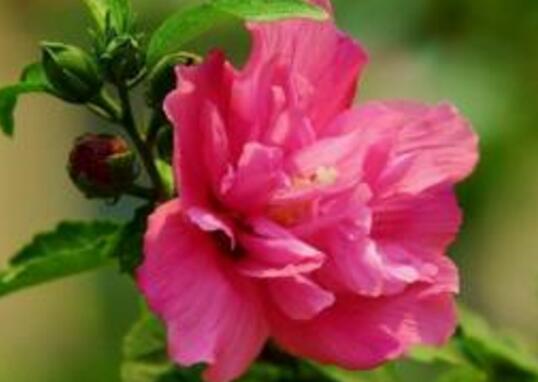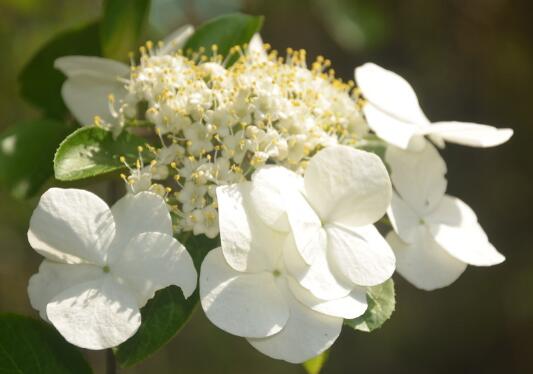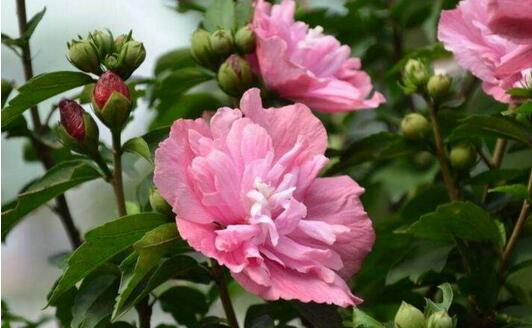How to raise hibiscus flowers, breeding methods and precautions of hibiscus flowers / water and fertilizer should not be excessive
We know that in the efficacy and function of hibiscus flower, it not only has high nutritional value, but also can treat many diseases, so there are many people who grow it, so how can hibiscus flower grow better? Let's take a look at the breeding methods and points for attention of hibiscus flowers.
How to raise hibiscus flowers

If you want to know the culture method of hibiscus flower, you must first understand its growth habits. Hibiscus flower is very adaptable to the environment, it has the characteristics of drought tolerance, shade tolerance, heat tolerance, cold tolerance, pruning resistance, moisture tolerance, poor soil resistance and so on, coupled with strong sprouting and tillering, so it is very easy to feed.
Hibiscus flower is suitable for the environment.
1. Soil
Hibiscus may have the most relaxed requirements for soil among plants. It can grow in heavy clay as well as poor soil, but it is better to use fertile, well-drained acidic soil to raise it better.
2. Temperature
Hibiscus flower has strong resistance to cold and heat, but it prefers a warm environment, so in the breeding methods and precautions of hibiscus flower, the temperature of 18-25 degrees is the most suitable, when it grows the fastest, and the temperature should not be lower than 0 degrees in winter and no higher than 35 degrees in summer.
3. Lighting
Hibiscus flower has outstanding shade tolerance, it can grow normally in semi-shady environment, but it prefers the environment with plenty of light, the lack of light will cause its flowers to be dim and blossom less, so it should be kept in a bright place for maintenance. If it is in full light, it should be shaded in summer.
Culture methods of hibiscus flower
1. Watering
Hibiscus flowers are very resistant to drought and moisture, but in the process of breeding, the soil should be avoided to be too dry or often accumulate water, so when watering, keep the soil moist, not let it be too dry, and spray water on the leaves in summer.
2. Fertilization
Hibiscus flowers are fertilizer-loving plants, so how to grow hibiscus flowers when fertilizing? Attention should be paid to rational fertilization, such as topdressing phosphorus and potassium fertilizer before budding, which can promote its flowering and make the flower color more colorful, while nitrogen fertilizer should be applied during the growing period to provide nutrition for growth and make the leaves greener.
3. Pruning
When hibiscus flowers germinate in spring, they can be shaped and pruned, and in the spring of the second year after planting, they can be cut off to promote basal branches, so that hibiscus flowers can be cultivated into an ideal tree shape and have higher ornamental value. in the breeding methods and matters needing attention of hibiscus flowers, pruning is easy to be ignored.
Points for attention in raising hibiscus flowers
1. Turn the soil and change the basin
Whether it is open field cultivation or pot cultivation, it is necessary to turn the soil or change the pot regularly, generally every 1-2 years, in order to ensure the good air permeability and drainage of the soil, and to prevent the soil from being too barren to affect flowering.
2. Soil disinfection
Although hibiscus does not have high requirements for the soil, it is not completely without requirements, and the most important thing is that the soil must be healthy and free of germs and eggs, which requires disinfection of the soil before planting.
3. Water and fertilizer should not be too much.
No matter watering or fertilizing, we should pay attention not to over-watering. We should not pour a large amount of water because it is resistant to moisture, causing the roots to soak in the water for a long time, while too much fertilization will lead to leaf thickening and affect the formation of flower buds. This skillful practice is not advisable when planting hibiscus flowers.
How to grow potted hibiscus flowers
If it is a family potted hibiscus flower, in addition to understanding the above points, we also need to pay attention to the prevention and control of diseases and insect pests, and the way to prevent them is to keep the environment ventilated and clean, and to treat them with drugs in time when diseases and insect pests occur, so as to avoid the spread of harm.
How to grow flowers in autumn and how to plant flowers in autumn
Autumn flower breeding methods, how to grow flowers in autumn?
1. Water it. For most flowers, water can be watered every two days according to the dry and wet condition of the basin soil; for flowers that bloom in autumn, winter or early spring and those sown in autumn, they can be watered normally according to the actual needs of each kind of flowers, and other flowers should gradually reduce the amount of watering, avoid excessive water and fertilizer, cause overgrowth, affect flower bud differentiation and survive the winter safely; for foliage plants that like humidity, in addition to watering every day, you should also spray one or two times. For some acidic flower species, an appropriate amount of ferrous sulfate can be added to the watering, the concentration is not more than 0.1%.
two。 Fertilize. As this is a period of exuberant growth of most flowers, in addition to ensuring water supply, fertilization is also very important. Different kinds and concentrations of fertilizers should be applied according to the habits and needs of different flower species.
For autumn chrysanthemum, sweet-scented osmanthus, camellia, rhododendron, etc., which bloom once a year, liquid fertilizer mainly based on phosphate fertilizer should be applied 2-3 times in time, otherwise not only the flowers are few and small, but also buds will fall; for rose, Milan, jasmine, mulberry, begonia, kumquat, pomegranate and other fruit plants that bloom many times a year, in addition to ensuring the supply of nitrogen fertilizer, appropriate amount of phosphate and potassium fertilizer, such as potassium dihydrogen phosphate and calcium superphosphate, should also be applied. For foliage plants such as tortoise back bamboo and Brazilian wood, low concentrations of nitrogenous liquid fertilizer can be applied to make the leaves lush and green; for most flowers, after Cold Dew, the temperature becomes lower in the north, so there is generally no more fertilization.
3. Plastic surgery and trimming. When the temperature is about 20 ℃ in autumn, many flowers will sprout twigs. Except for some of the twigs to be retained, the rest should be cut off in time to reduce nutrient consumption. The retained twigs should also be picked in time to prevent them from growing; for autumn buds such as chrysanthemum, rose and hibiscus, the lateral buds should be removed in time except for a main bud with a good growth at the top; for species that have flowered for a long time, such as rose, mulberry, jasmine, geranium, etc., the stump that has flowered should be removed in time, and the branches that have already flowered should be trimmed to promote the growth of lower lateral shoots in order to bloom continuously.
Before and after the Cold Dew Festival in the northern region, most flowers have to move indoors according to their cold resistance to survive the winter in order to avoid cold damage. The time of entry should vary according to the type of flowers and the area in which they are located. For most flowers, if there is no frost when the weather is just getting cold, do not rush to move indoors, because entering the house too early will affect the accumulation of nutrients and is not conducive to fertility in the coming year. Therefore, under the premise of not suffering from cold injury, the time of entering the room should be a little later.
Three key points for the maintenance of flowers in autumn
Autumn is a season with changeable temperatures, such as summer in early autumn, better in mid-autumn, and cold in late autumn. This is also the time when most flowers enter their second growth period. For flowers at this time, water and fertilizer management is extremely important.
For most flowers, water can be watered every two days according to the dry and wet condition of the basin soil; for flowers that bloom in autumn, winter or early spring and those sown in autumn, they can be watered normally according to the actual needs of each kind of flowers, other flowers should gradually reduce the amount of watering, avoid excessive water and fertilizer, cause overgrowth, affect flower bud differentiation and survive the winter safely; for wet foliage plants, in addition to watering every day, you should also spray one or two times. For some acidic flower species, an appropriate amount of ferrous sulfate can be added to the watering, the concentration is not more than 0.1%.
Fertilization as this is a period of exuberant growth of most flowers, fertilization is also very important in addition to ensuring water supply. Different kinds and concentrations of fertilizers should be applied according to the habits and needs of different flower species. For autumn chrysanthemum, sweet-scented osmanthus, camellia, rhododendron, etc., which bloom once a year, liquid fertilizer mainly based on phosphate fertilizer should be applied 2-3 times in time, otherwise not only the flowers are few and small, but also buds will fall; for rose, Milan, jasmine, mulberry, begonia, kumquat, pomegranate and other fruit plants that bloom many times a year, in addition to ensuring the supply of nitrogen fertilizer, appropriate amount of phosphate and potassium fertilizer, such as potassium dihydrogen phosphate and calcium superphosphate, should also be applied. For foliage plants such as tortoise back bamboo and Brazilian wood, low concentrations of nitrogenous liquid fertilizer can be applied to make the leaves lush and green; for most flowers, after Cold Dew, the temperature becomes lower in the north, so there is generally no more fertilization.
When the temperature of shaping and pruning is about 20 ℃ in autumn, many flowers will sprout twigs. Except for some of the twigs to be retained, the rest should be cut off in time to reduce nutrient consumption. The retained twigs should also be picked in time to prevent them from growing; for autumn buds such as chrysanthemum, rose and hibiscus, the lateral buds should be removed in time except for a main bud with a good growth at the top; for species that have flowered for a long time, such as rose, mulberry, jasmine, geranium, etc., the stump that has flowered should be removed in time, and the branches that have already flowered should be trimmed to promote the growth of lower lateral shoots in order to bloom continuously.
Before and after the Cold Dew Festival in the northern region, most flowers have to move indoors according to their cold resistance to survive the winter in order to avoid cold damage. The time of entry should vary according to the type of flowers and the area in which they are located. For most flowers, if there is no frost when the weather is just getting cold, do not rush to move indoors, because entering the house too early will affect the accumulation of nutrients and is not conducive to fertility in the coming year. Therefore, under the premise of not suffering from cold injury, the time of entering the room should be a little later.
- Prev

How to raise Qionghua, the breeding methods and precautions / sufficient sunshine of Qionghua
Qionghua is not only a kind of famous flower unique to our country, but also the city flower of Yangzhou City, Jiangsu Province. It has a reputation of only one flower, and there are no similar flowers all over the world. There are also many people who breed it in Yangzhou area, but there are many places that need to be paid attention to. How to raise Qionghua? What are the culture methods and matters needing attention of Qionghua?
- Next

How to water hibiscus flowers, do not dry, do not water / water thoroughly after drying / ensure that the soil is well drained
The drought tolerance of hibiscus flower is relatively strong, so watering should be paid attention to when planting it, and watering is also an important part of the breeding method of hibiscus flower, so how to water hibiscus flower is better? The editor came to tell you the answer.
Related
- Fuxing push coffee new agricultural production and marketing class: lack of small-scale processing plants
- Jujube rice field leisure farm deep ploughing Yilan for five years to create a space for organic food and play
- Nongyu Farm-A trial of organic papaya for brave women with advanced technology
- Four points for attention in the prevention and control of diseases and insect pests of edible fungi
- How to add nutrient solution to Edible Fungi
- Is there any good way to control edible fungus mites?
- Open Inoculation Technology of Edible Fungi
- Is there any clever way to use fertilizer for edible fungus in winter?
- What agents are used to kill the pathogens of edible fungi in the mushroom shed?
- Rapid drying of Edible Fungi

